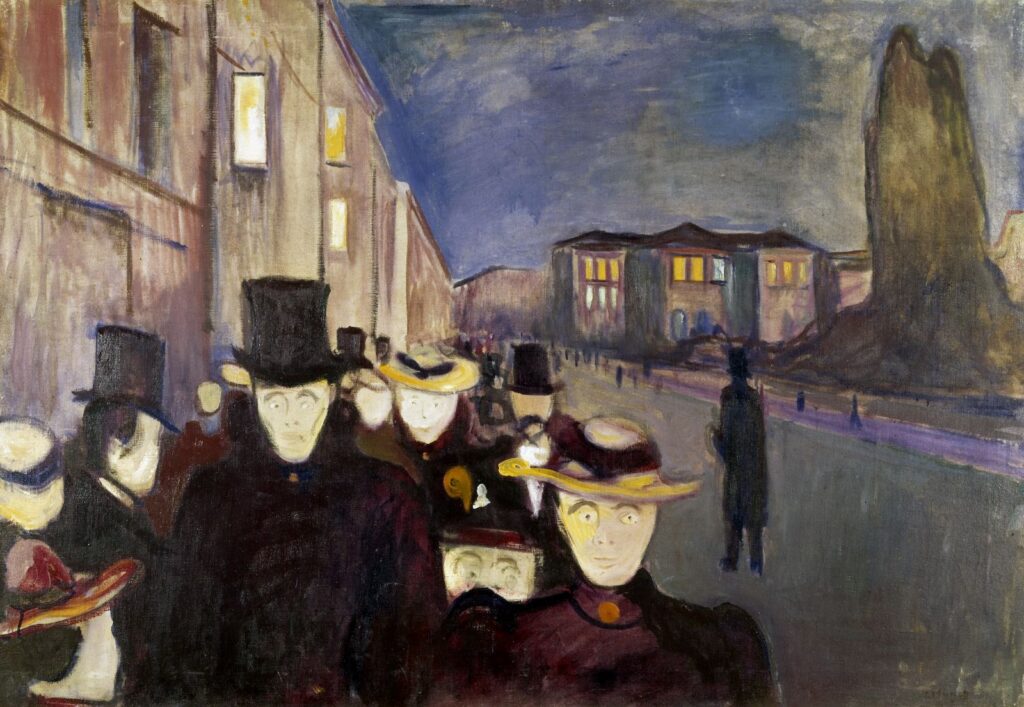Urban Revolutionaries: 15 Angst

At times, life in the country was thoroughly miserable, but in the cities there was and is plenty of angst, the strain resulting from the stress of life. Wherever you looked there were people, buildings, crowds, bustle. This started to affect artists living and working in Paris, Copenhagen, Stockholm, and became a major theme in the paintings of Edvard Munch even in the relatively small city of Oslo, then named Kristiania.
Gustave Caillebotte (1848–1894), Vue de toits (effet de neige) (Rooftops in the Snow (snow effect)) (1878), oil on canvas, 64 x 82 cm, Musée d’Orsay, Paris. Wikimedia Commons.
It was perhaps Gustave Caillebotte in his pioneering painting of Rooftops in the Snow (snow effect) from 1878 that first showed the bleak desolation of the world above Paris, with its atmospheric greyness and sketchy forms. Although there are a few leafless trees reaching up into this other world, it’s dominated by chimneys as far as you can see.
Serhii Svitoslavskyi (1857–1931), From the Windows of Moscow School of Painting (1878), media and dimensions not known, Tretyakov Gallery Государственная Третьяковская галерея, Moscow, Russia. Wikimedia Commons.
In the same year, and when he was only twenty-one, Serhii Svitoslavskyi painted what remains his best-known work, this view From the Windows of Moscow School of Painting. Although less bleak and with more trees, the city here stretches on without end.
Laurits Andersen Ring (1854–1933), Young Girl Looking out of a Roof Window (1885), oil on canvas, 33 × 29.5 cm, Nasjonalgalleriet, Oslo, Norway. Wikimedia Commons.
Many Naturalist artists were migrants from the country. Here, in his Young Girl Looking out of a Roof Window (1885), countryman LA Ring expresses some of their feelings when trapped in a garret amid the grey urban roofscape of Copenhagen.
Eugène Jansson (1862–1915), Sunrise Over the Rooftops. Motif from Stockholm (1903), oil on canvas, 150 x 210 cm, Nationalmuseum, Stockholm, Sweden. Wikimedia Commons.
In Stockholm, Eugène Jansson’s Sunrise Over the Rooftops. Motif from Stockholm shows the winter of 1903, with snow lying on those roofs and smoke rising from chimneys.
The greatest expression of the angst of the city came in Edvard Munch’s series The Frieze of Life, painted during the 1890s and first exhibited in Berlin in 1895. This culminates in one of the best-known paintings in the Western canon.
Edvard Munch (1863–1944), Anxiety (1894), oil on canvas, 94 x 74 cm, Munchmuseet, Oslo. Wikimedia Commons.
The first of the five paintings in this section presents a composite summary, originally known as Insane Mood then Red Clouds at the time this version of the Frieze was exhibited.
It uses the same setting and colour as The Scream, which ends this section, but is populated with the crowd from Evening on Karl Johan below. In this context it does more than that, in providing the individual elements that are teased out and developed by the other paintings in this section.
Edvard Munch (1863–1944), Evening on Karl Johan (1892), oil on canvas, 84.5 × 121 cm, Bergen kunstmuseum, Bergen, Norway. Wikimedia Commons.
First, Evening on Karl Johan shows the crowd from Anxiety in an autobiographical scene. During Munch’s affair with ‘Mrs Heiberg’, he had arranged to meet her on Karl Johans Gate, the long, straight main street in the centre of Oslo. As he waited for her, his anxiety grew, exacerbated by crowds of people walking towards him.
Munch’s later depiction of this greatly foreshortens the perspective of this section of the street from the Royal Palace towards the Storting (parliament building), a distance of around 300 metres. This packs the pedestrians together and, coupled with their nightmarish faces, enhances its troubling feeling of anxiety.
Edvard Munch (1863–1944), Red Virginia Creeper (1898-1900), oil on canvas, 119.5 × 121 cm, Munchmuseet, Oslo. Wikimedia Commons.
Red Virginia Creeper develops the red theme from Anxiety. One of the paintings which Munch made after his first version of the Frieze to augment it for its second version, it contrasts with Evening on Karl Johan by its relatively open and undistorted view. The building shown is Kiøsterud in Åsgårdstrand, which Munch also included in his slightly later Girls on the Bridge (c 1902).
This painting develops the theme of anxiety, with the creeper staining the walls of the building blood red, and enclosing it in its deadly embrace. In the foreground, almost oblivious of the building behind, is the anxious face of a man with a drooping moustache and pointed beard, staring at the viewer. The model for that face was most probably the author Stanislaw Przybyszewski, who also featured in Munch’s Jealousy.
Edvard Munch (1863–1944), The Scream (1893), oil, tempera and pastel on cardboard, 91 × 73.5 cm, Nasjonalgalleriet, Oslo. Wikimedia Commons.
This section closes with The Scream, showing the isolated figure of Munch before the distant city of Oslo, its fjord with ships at anchor, and the surrounding hills. As the artist’s notes explain:
I was walking along a path with two friends. The sun was setting. I felt a breath of melancholy. Suddenly the sky turned blood-red. I stopped and leant against the railing, deathly tired, looking out across flaming clouds that hung like – blood and a sword over the deep blue fjord and town. My friends walked on – I stood there trembling with anxiety, and I felt a great, infinite scream pass through nature.

